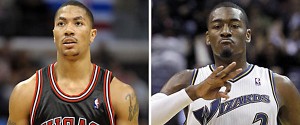
Derrick Rose and John Wall are products of the one-and-done system that is currently in place in the NBA. (Getty Images photos)
Once the old collective bargaining agreement expires at midnight EST on June 30, NBA owners and players need to take a hard look at the current state of the early entry draft.
The way things are currently constructed, any American player who is 19 years of age and at least one year removed from high school can apply for the draft. With this option, the majority of high school standouts play one year in college and bolt for the NBA.
In the last five drafts, four one-and-done college players were the No. 1 overall selections: Greg Oden (2007), Derrick Rose (2008), John Wall (2010) and Kyrie Irving (2011).
Yahoo! Sports NBA writer Marc Spears wrote earlier this year that several high-ranking NBA team executives say they wouldn’t be surprised if the age limit in the new CBA is pushed to two years in college and 20 years old by the end of that calendar year. Spears said that one NBA general manager says about two-thirds of teams are in favor of that change.
That makes total sense because now the NBA and its owners have a vested interest in the college game thanks to the new14-year, $10.8 billion TV deal the NCAA inked with CBS, TNT, TBS and truTV to broadcast the men’s tournament.
Before the billion-dollar deal, the NBA could care less about players jumping to the league. With TNT now in the mix covering March Madness, it now becomes a major player in college hoops and would love to feature its college stars. Even though the NBA and TNT are two separate entities (wink, wink), they are in business together and what’s good for business is having more college All-Americans stay in school for at least two years to help to boost the ratings. At the same time, it keeps the teenagers out of the Association for a little longer, which means more jobs for the below-average NBA veterans.
As much as basketball analysts say college basketball is all about the names on the front of the jerseys instead of back of the jerseys, what attracts the non-hardcore basketball fans are the big-time athletes on the big-time teams.
High schoolers Martell Webster, Gerald Green, Eddy Curry, Sebastian Telfair, Dorell Wright and J.R. Smith would have benefited greatly from a year or two in college, but then again that argument gets swept away when you mention Kobe Bryant, LeBron James, Dwight Howard, Kevin Garnett and Amar’e Stoudemire. All of these phenoms were able to make the jump from high school to the pros with ease, and absolutely destroys the argument that you need to play college ball to be successful in the NBA.
So, what should Commissioner David Stern and the owners do about this one-and-done dilemma? Keep it or lose it? The answer lies in the dollar, and the new NCAA tournament TV deal makes the current early entry rule a chip the players could lose on the bargaining table.
Joel Huerto is the editor and publisher of OneManFastBreak.net. Follow him on Twitter at: twitter.com/onemanfastbreak.